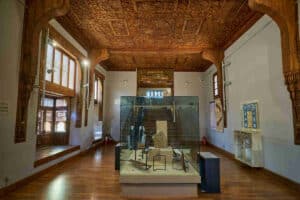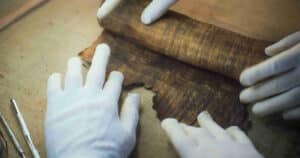For many, the bust of Nefertiti is the most beautiful sculpture ever created simply because it represents a universal aesthetic standard, which remains intact despite over 3,000 years since its creation. Hence, it has become not only an icon of the Pharaonic civilization but also of feminine beauty in general. But where exactly is the bust of Nefertiti located? We reveal it in this post and provide additional information about this queen and this work of art.
Who was Nefertiti?
Before diving into the location of Nefertiti’s bust, it’s pertinent to briefly outline who this queen was, as her immense significance undoubtedly magnifies her legend. Nefertiti was the wife of Amenhotep IV, a pharaoh of the 18th dynasty, who renamed himself Akhenaten. He’s also known as the ‘heretic pharaoh’, for his reign marked a significant schism for that civilization: he abandoned polytheism in favor of worshiping the solar disk, Aten.
Furthermore, he moved the capital from Thebes (modern-day Luxor) to Akhetaten (present-day Amarna), establishing a highly refined court. It’s in this context of refinement and naturalistic art that the bust of his wife, Nefertiti, stands out, renowned for its stylized and subtle features, leaning towards an elongated silhouette.
Berlin, the Home of Nefertiti’s Bust
Beyond the significance of the figure, another factor that may have contributed to the international fame of Nefertiti’s bust is its location outside of Egypt, in the city of Berlin. The greater proximity of the German capital to Western circles and the promotion of the sculpture as a genuine tourist attraction have granted it a special place in the collective imagination.
Specifically, it is the Neues Museum that houses the bust of Nefertiti, nestled within the prestigious setting known as Museum Island, in close proximity to other important institutions like the Pergamon Museum and the Altes Museum.
However, it’s worth noting that there’s a heated debate regarding its potential restitution to Egypt, as the nation demands. While the artifact left Egypt with the proper documentation in 1913, some historians question the integrity of the process for obtaining this permission. Currently, archaeologists and media figures like Zahi Hawass advocate for the return of the piece as an act of historical redress.
Is There Anything Similar to This Bust in Egypt?
As mentioned, Egypt is now fervently demanding the return of Nefertiti’s bust, in line with the global movement known as “museum decolonization.” Because of this, numerous references to Nefertiti’s bust can be found within Egypt, even if it isn’t located within its borders.
The most notable example is the colossal sculpture erected in a square in Menia, the city that will house the future Aten Museum and is located close to the historical capital Akhetaten, in Amarna.
And for those particularly intrigued by the figure and the beauty standards she embodies, another worthwhile visit is the Egyptian Museum in Cairo. Here, another bust of Nefertiti is preserved – this one unfinished, but likely from the same period, and perhaps even crafted by the same sculptor.
Now you know where Nefertiti’s bust is located and about other versions associated with it. If you wish to learn more about the figure and the civilization that birthed her, don’t hesitate to take a tour of Egypt and visit enchanting destinations closely related to this queen, such as Luxor, Cairo, or Amarna.




